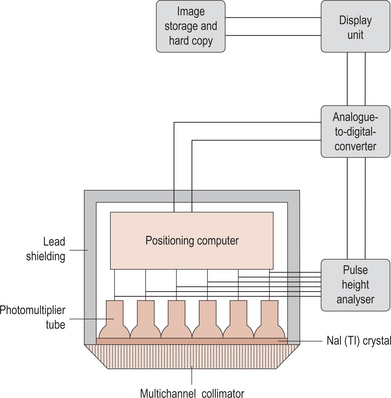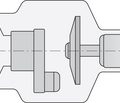G
gag the reflex contraction of the pharyngeal muscles and elevation of the palate when the soft palate or posterior pharynx is stimulated. An instrument used to keep the mouth open.
gain (swept gain) the amount of sound received back by an ultrasonic transducer, increasing the gain visualizes the organs further away from the probe.
gain correction a factor used to compensate for the variation in electrical signal for an absorbed intensity of radiation between detector channels in CT scanning.
gait a manner or style of walking. ataxic gait an incoordinate or abnormal gait. cerebellar gait reeling, staggering, lurching. scissors gait one in which the legs cross each other in progressing. spastic gait stiff, shuffling, the legs being held together. tabetic gait the foot is raised high then brought down suddenly, the whole foot striking the ground.
Galeazzi fracture–dislocation fracture of the distal radius with dislocation of the radioulnar joint.
gallbladder a pear-shaped bag on the undersurface of the liver, it concentrates and stores bile.
gallows traction see Bryant’s ‘gallows’ traction.
gallstones concentrations of cholesterol or other constituents of bile formed within the gallbladder or bile ducts; many small stones or one large stone may be formed.
galvanometer an instrument for measuring an electrical current.
gamete a female or male reproductive cell with the haploid (n) chromosome number; oocyte or spermatazoon.
gametogenesis production of gametes (oocytes and spermatozoa). See also oogenesis, spermatogenesis.
gamma the measure of the slope of a characteristic curve, the higher the gamma the higher the contrast on the radiographic film. See also average gradient, sensitometry.
gamma camera a large, stationery, scintillation counter, which records the activity over the whole field at the same time. Used to detect pathologies where the physiology of the structure is changed. The image is viewed on a cathode ray tube (see figure on p. 172).
gamma decay the emission of gamma rays from a nucleus which has excess energy.

The main components of a gamma camera and its associated circuitry.
From Principles of radiological physics, 3rd edn, D T Graham, 1996, Churchill Livingstone, Edinburgh, with permission.
gamma encephalography a small dose of isotope is given which is concentrated in many cerebral tumours, the pattern of radioactivity is then measured.
gamma knife a method of treating tumours that are difficult to excise surgically by using multiple beams of radiation, focused at the tumour over a number of days.
gamma rays short wavelength, penetrating rays of the electromagnetic spectrum produced by disintegration of the atomic nuclei of radioactive elements.
ganglion a mass of nerve cell bodies in the peripheral nervous system such as those of the autonomic nervous system and those ganglia containing the cell bodies of sensory nerves. Localized cyst-like swelling near a tendon, sheath or joint. Sometimes occurs on the back of the wrist due to strain such as excessive use of a word processor. See also gasserian ganglion.
gangrene death of part of the tissues of the body. Usually the results of inadequate blood supply, but occasionally due to direct injury (traumatic gangrene) or infection (e.g. gas gangrene). Deficient blood supply may result from pressure on blood vessels (e.g. tourniquets, tight bandages and swelling of a limb); from obstruction within healthy vessels (e.g. arterial embolism, frostbite where the capillaries become blocked); from spasm of the vessel wall (e.g. ergot poisoning); or from thrombosis due to disease of the vessel wall (e.g. arteriosclerosis in arteries, phlebitis in veins). See also dry gangrene, moist gangrene.
gantry a structure or support, in CT scanning a structure in which the X-ray tube, detectors and associated electronics are housed.
Gardner’s syndrome familial polyposis of the large bowel, with fibrous dysplasia of the skull, extra teeth, osteomas, fibroma and epidermal cysts.
gargoylism congenital disorder of mucopolysaccharide metabolism with recessive or sex-linked inheritance. The polysaccarides chondroitin sulphate ‘B’ and heparitin sulphate are excreted in the urine. Characterized by skeletal abnormalities, coarse features, enlarged liver and spleen, learning disability.
gas one of the three states of matter, the others being solid and liquid. A gas retains neither shape nor volume when released.
gas gangrene a serious wound infection caused by anaerobic organisms of the genus Clostridium, especially Clostridium perfringens (welchii), a soil microbe often present in the intestine of humans and animals. See also gangrene.
gasserian ganglion a mass of nerve cell bodies deeply situated within the skull, on the sensory root of the fifth cranial nerve. It is involved in trigeminal neuralgia.
gas transfer factor measurement of the lung’s ability to exchange gases. Particularly useful in the diagnosis and surveillance of interstitial lung diseases, sarcoidosis and emphysema.
gastrectomy surgical removal of all or part of the stomach.
gastrin a hormone secreted by the gastric mucosa on entry of food, which causes further gastric secretion.
gastritis inflammation of the stomach.
gastrocnemius the large two-headed muscle of the calf.
gastrocolic associated with the stomach and the colon.
gastrocolic reflex sensory stimulus when food enters the stomach, resulting in strong peristaltic waves in the colon.
gastroduodenal associated with the stomach and the duodenum.
gastroenteritis inflammation of the stomach and intestines.
gastrointestinal associated with the stomach and intestine.
gastro-oesophageal associated with the stomach and oesophagus.
gastro-oesophageal reflux disease caused by passage of gastric contents into the oesophagus, typically causes heartburn, complications include ulceration, strictures and Barrett’s oesophagus.
gastrophrenic associated with the stomach and diaphragm.
gastroschisis a portion of bowel appearing through a defect in the abdominal wall, near the umbilicus.
gastrulation in early embryonic development the immense changes occurring as the blastocyst becomes the gastrula. The three primary germ layers are formed and cells move to their appointed locations in readiness for the start of structural development.
gate a gate performs a single logical operation when subjected to a number of inputs. It is the basis of all computer operations.
Gauss an electromagnetic unit of magnetic induction now replaced by the Tesla (1 Tesla = 10000 Gauss).
Geiger counter a device for detecting and registering radioactivity.
Geiger–Muller counter a device for measuring radiation dosage, it has a glass envelope containing argon, a positively charged central electrode and a negatively charged mesh cylinder.
Geiger–Muller tube a radiation detector using an ionization chamber, used in personnel dosimetry and to detect the movement of gamma ray sources in brachytherapy.
gelatine a complex compound used in the emulsion layer of a radiographic film to allow the absorption of water during chemical processing, keeping the silver halide grains in suspension, during manufacture to allow the grains to grow and bind the emulsion to the base of the film, it assists with forming and stabilizing the image during and after exposure to electromagnetic radiation.
gemellus muscles muscles arising from the ischium.
general anaesthetic a drug which causes unconsciousness by inhalation or injection of the drug.
General Medical Council (GMC) the statutory body that regulates the practice of medicine in the UK. It oversees professional quality and continuing professional development standards for professional practice, discipline and conduct. It is responsible for the establishment and maintenance of a professional register for all doctors working in the UK, and has the power to remove individuals from the register in cases of professional misconduct, or in some cases to restrict practice or order specific training.
General Medical Services the medical services provided by family doctors.
Stay updated, free articles. Join our Telegram channel

Full access? Get Clinical Tree





